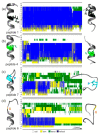Intact Transition Epitope Mapping-Force Differences between Original and Unusual Residues (ITEM-FOUR)
- PMID: 36671572
- PMCID: PMC9856199
- DOI: 10.3390/biom13010187
Intact Transition Epitope Mapping-Force Differences between Original and Unusual Residues (ITEM-FOUR)
Abstract
Antibody-based point-of-care diagnostics have become indispensable for modern medicine. In-depth analysis of antibody recognition mechanisms is the key to tailoring the accuracy and precision of test results, which themselves are crucial for targeted and personalized therapy. A rapid and robust method is desired by which binding strengths between antigens and antibodies of concern can be fine-mapped with amino acid residue resolution to examine the assumedly serious effects of single amino acid polymorphisms on insufficiencies of antibody-based detection capabilities of, e.g., life-threatening conditions such as myocardial infarction. The experimental ITEM-FOUR approach makes use of modern mass spectrometry instrumentation to investigate intact immune complexes in the gas phase. ITEM-FOUR together with molecular dynamics simulations, enables the determination of the influences of individually exchanged amino acid residues within a defined epitope on an immune complex's binding strength. Wild-type and mutated epitope peptides were ranked according to their experimentally determined dissociation enthalpies relative to each other, thereby revealing which single amino acid polymorphism caused weakened, impaired, and even abolished antibody binding. Investigating a diagnostically relevant human cardiac Troponin I epitope for which seven nonsynonymous single nucleotide polymorphisms are known to exist in the human population tackles a medically relevant but hitherto unsolved problem of current antibody-based point-of-care diagnostics.
Keywords: ITEM-FOUR; immune complex analysis; nanoESI mass spectrometry; personalized genomics; single amino acid polymorphism.
Conflict of interest statement
The authors declare no conflict of interest.
Figures





References
Publication types
MeSH terms
Substances
Grants and funding
LinkOut - more resources
Full Text Sources
Research Materials

